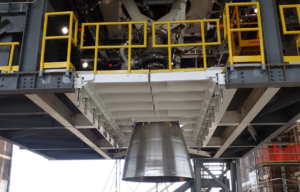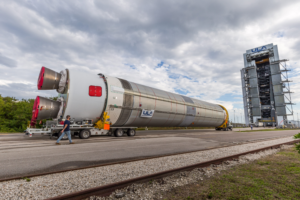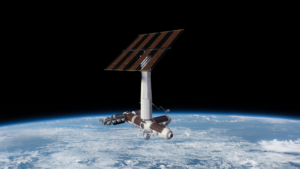
Progress Is Being Made On A Crewed Dream Chaser
In the past, the Space Shuttle, while by no means perfect, managed to launch over 100 times and help place a lot of the space infrastructure still in use today. It could be used to carry large crews, or massive payloads thanks to its large bay. The spaceplane design was fascinating to many, however, we haven’t quite seen anything like it since.
Throughout Dream Chaser’s extensive history, the spaceplane has gone from a crewed vehicle to an uncrewed spacecraft to both. The current approach is to separate the vehicle into three separate variants, each with a specific purpose. The primary and first to launch is the uncrewed version which is set to lift off later this year. However, we just got more news on the future of a crewed Dream Chaser.
A new agreement with NASA is focusing on the DC-201 crewed spaceplane. Specifically, through the agreement, Sierra Space will provide NASA with insight and collaboration into its crewed Dream Chaser spaceplane. This announcement is significant as it’s been quite rare that Sierra Space reveals information relating to its plans for crewed flight. Here I will go more in-depth into the history of Dream Chaser’s crew aspirations, the new agreement, what to expect in the coming months, and more.
Crewed or Uncrewed?

Right now, Sierra Space is finishing work on Dream Chaser Tenacity, an uncrewed variant and the first test article scheduled to go to space. At the same time as physical work is being completed on this specific spaceplane, the company is working behind the scenes on a future crewed system. Just days ago on the 16th, Sierra Space tweeted saying, “Sierra Space has been awarded a Space Act Agreement (SAA) by @NASA under the second Collaborations for Commercial Space Capabilities (CCSC-2) initiative.”
In a statement the company wrote, “Through the agreement, Sierra Space will provide NASA with valuable insight and collaboration into its crewed Dream Chaser® spaceplane; new commercial space station architectures; and in-space logistics, refueling and servicing systems. NASA will advance deployment of Sierra Space’s platform and ecosystem by providing access to facilities and support for environmental and crew systems testing, tools and software.
Provided in the tweet was a new render of the crewed spaceplane docking to the company’s LIFE Habitat. Here you can see the markings DC-201 signifying it’s the crewed variant. The only other somewhat recent update on this system was months ago in January when Sierra Space released an image showcasing a crewed and uncrewed variant. This was quite a big deal as it revealed some of the major changes being made to the new system. Up until then, the only differences between the crewed and uncrewed variant was supposed to be windows, life support systems, and a main propulsion system.
The Dream Chaser page is even quoted saying, “The crewed version of Dream Chaser is approximately 85% common to the cargo system, limiting primary changes to windows, environmental control and life support systems. In addition, an integral main propulsion system is available for abort capability and major orbital maneuvers.”
Looking at these renders, however, there seem to be quite a few more differences. For one, the crewed version features a lower profile and looks similar to a drone. The wings are also fixed in place, unlike the uncrewed version which folds its wings. This is because the crewed variant will always launch without farings and doesn’t need to fit within a 5-meter diameter space. This has to do with the abort capability and crew safety. It also features more control surfaces toward the top of the spacecraft. Not to mention no windows in sight. In reality, in combination with the different internal life support systems to support the crew, the crewed version is very different.
Focusing back on the recent NASA agreement, Sierra Space CEO Tom Vice commented, “Sierra Space is building the in-space infrastructure and end-to-end business platform to accelerate the new space economy. This agreement with NASA enables active collaboration to share our expertise and findings as we conduct the formative work that will open the door to extended human missions to space” he said.
In the near future, we can expect more updates on the crewed version and when exactly it’s expected to be operational. By now it’s obvious Sierra Space is very interested in the crewed route and is working hard to get there. The results of the uncrewed Dream Chaser’s initial and following flights will heavily impact the timeline of the crewed variant.
The Loss of Crew Contracts

At the very start, the Dream Chaser design was derived from NASA’s HL-20 Personnel Launch System spaceplane concept. This was a concept for crewed orbital missions studied by NASA’s Langley Research Center all the way back in 1990. Even years later when Sierra Space took over the design, the plan was to create a human rated Dream Chaser Space System version designed to carry from three to seven people and cargo to orbital destinations such as the International Space Station. It was to have a built-in launch escape system and fly autonomously if needed.
Around 2010, Sierra Space even began winning money from NASA awards related to the crewed Dream Chaser design. Specifically, Sierra Nevada Corporation was awarded $20 million in seed money under NASA’s Commercial Crew Development (CCDev) phase 1 program for the development of the Dream Chaser. Next, Sierra Nevada proposed Dream Chaser for the CCDev phase 2 solicitation by NASA in October 2010, with an estimated project cost of less than $1 billion. 1 year later, NASA awarded $80 million to Sierra Nevada Corporation for Dream Chaser. Since then, nearly a dozen further milestones have been completed under that Space Act Agreement. Some of these milestones included testing of an improved airfoil fin shape, integrated flight software and hardware, landing gear, a full-scale captive carry flight test, and a Systems Requirement Review.
Unfortunately for Sierra Space and the Dream Chaser program, in 2014, NASA did not select Dream Chaser for CCtCap, the next phase of the Commercial Crew Program. To make matters worse, months after the decision, the GAO denied Sierra Nevada’s challenge, stating that NASA made the proper decision when it decided to award Boeing $4.2 billion and SpaceX $2.6 billion to develop their vehicles.
At the time, Ralph White, the GAO’s managing associate counsel, announced that NASA “recognized Boeing’s higher price but also considered Boeing’s proposal to be the strongest of all three proposals in terms of technical approach, management approach and past performance, and to offer the crew transportation system with most utility and highest value to the government.” Furthermore, the agency found “several favorable features” in SNC’s proposal “but ultimately concluded that SpaceX’s lower price made it a better value.”
The document stated Sierra Nevada’s Dream Chaser lifting body was not selected to ferry astronauts to the International Space Station (ISS) for various reasons which included having “significantly more technical work” and the “longest schedule for completing certification” among the three competitors for the contract. This was when the company put a pause on the crewed Dream Chaser variant. Around one year after not being selected, NASA announced that Dream Chaser had been awarded one of the CRS-2 contracts and committed to purchasing a minimum of six uncrewed resupply missions to the ISS. This cemented the decision for the company to hold off on the crewed Dream Chaser and focus on transporting cargo.
As far as current progress, only yesterday the company tweeted pointing out, “Members of the Sierra Space team recently toured @ulalaunch’s Decatur, Alabama facility to see #VulcanRocket hardware in production – an exciting preview of the technology that will launch our Dream Chaser spaceplane to the @Space_Station.” In regard to this, years ago it was announced that all six Dream Chaser CRS-2 flights would be carried into orbit by ULA’s Vulcan launch vehicle, with the first Dream Chaser flight being the second Vulcan flight in late 2021.
In terms of the upcoming mission, it was very recently delayed from this summer to December, and could face even more delays. ULA is trying to launch Vulcan for the first time and a few things have come up along the way that continue to push the flight back. Most notably an explosion of a Vulcan test upper stage is being investigated prior to launch. Combine this with even more work needed on Tenacity and the mission may continue to get pushed back.
On the bright side, the second Vulcan which will carry Tenacity looks to be making good progress and should be ready soon. The limiting factor will be the first Vulcan launch and the results of this mission. A static fire was also just completed with the BE-4 engines. ULA reported great results and should move on soon to payload integration and launch.
Conclusion
Dream Chaser has plans to feature both a human and cargo version. We just got a small update on the crewed Dream Chaser from a new agreement with NASA. This confirms the continued work on the program and hopefully more updates in the near future. We will have to wait and see how it progresses and the impact it has on the space industry.



